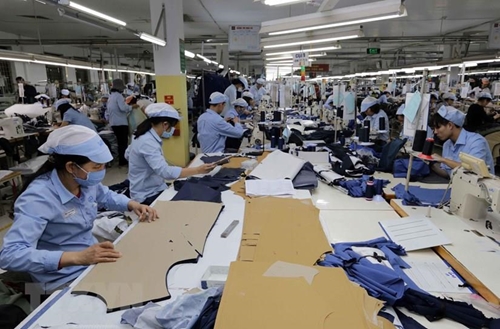Among the commodities with high export revenue to the EU in the first half of 2019, textile-garment brought home over 15 billion USD, up 9.9 percent year on year, according to the Ministry of Industry and Trade (MoIT).
Vice Chairman of the Vietnam Textile and Apparel Association Truong Van Cam said right since late 2018 and early 2019, many businesses have received enough orders for export until the end of September and even the whole year. Notably, the recent influx of investment capital has helped the textile-garment sector gradually perfect its domestic supply chains, which will boost products’ competitiveness.
    |
 |
|
EU textile-garment exports brought home over 15 billion USD in the first half of 2019. |
In particular, the EVFTA has opened the door wide for Vietnamese exports to European markets, and textile-garment and footwear are among the big beneficiaries of this deal, he noted.
Pham Thi Thu Huong, CEO of the Minh Tri Co. Ltd, said in 2018 and earlier, her company’s textile-garment exports to the EU accounted for only 10 percent of its total overseas shipments.
As the EU is a demanding market, in the past, the firm only had small orders. Since early 2019, to gear up for the EVFTA, it has increased investment to expand producing items for export to the EU, she noted.
As a result, Minh Tri recorded a year-on-year rise of 18 percent in its exports to this market in the first six months of 2019, and hopes that the figure will reach 25 percent for the whole year.
Huong said the company is having high expectations of the EU because this is a market with high value. Its shipments can further increase in the years ahead.
She added when the EVFTA takes effect, it will open up numerous new opportunities for textile-garment businesses. They will have more chances to enter this giant market, sell their products at higher prices and improve their manufacturing capacity via the application of new production technologies.
According to Director of the MoIT’s European-American Market Department Ta Hoang Linh, aside from preferential tariffs, the EVFTA also includes strict requirements. If Vietnamese firms do not make preparations right from now, it will be hard for their products to benefit from these preferential treatments.
Rules of origin are among the issues that companies must comply with so as to ship goods to the EU since most of materials of Vietnamese exports currently come from China and ASEAN.
To be subject to preferential tariffs, products must be made with certain rates of materials from Vietnam or the EU, the official elaborated.
Huong admitted that the country’s textile-garment sector still depends much on materials from China. To make use of FTAs, including the one with the EU, businesses should build strategies for developing domestic supply chains to satisfy the rules of origin. Additionally, authorised agencies also need to step up administrative and customs procedure reforms to help firms save cost and time.
Echoing the view, Linh said enterprises should be more active in ensuring their material supply so as to meet the EU’s rules of origin, thus helping to expand the market share of Vietnamese textile-garment in this market.
Source: VNA